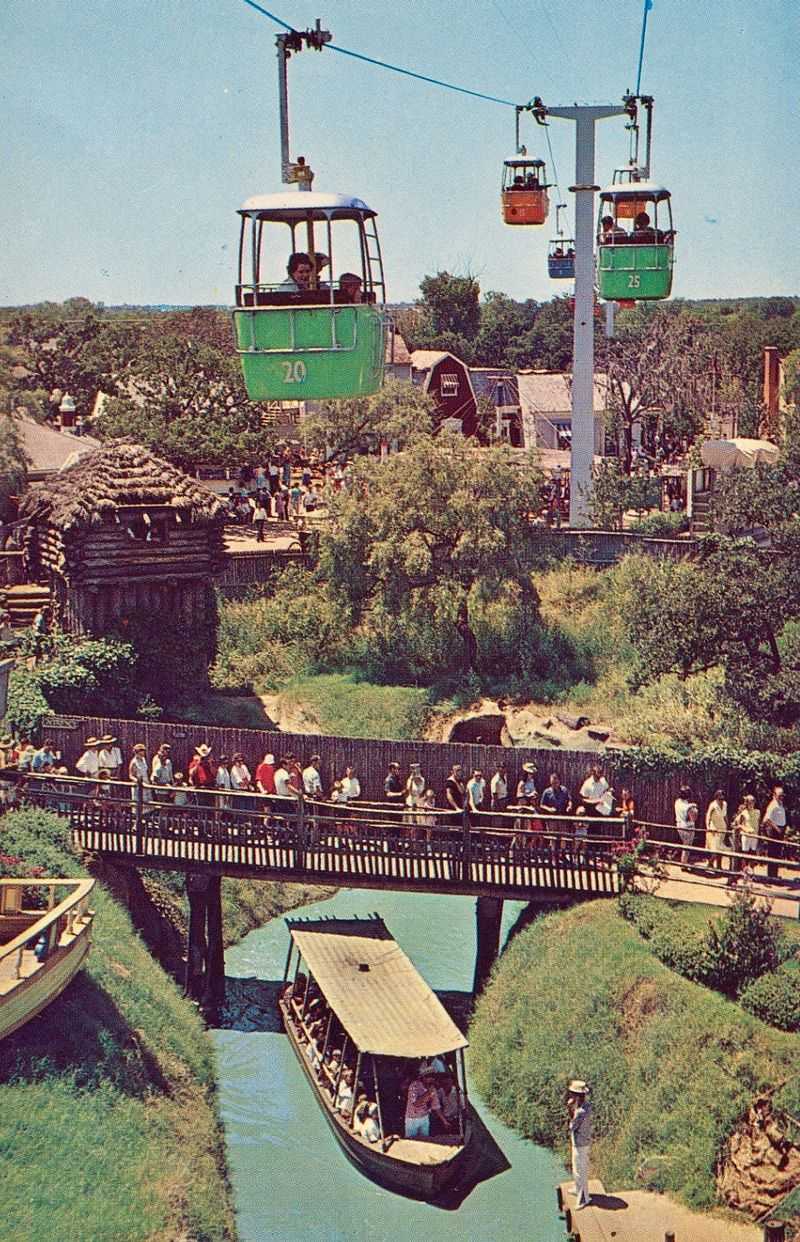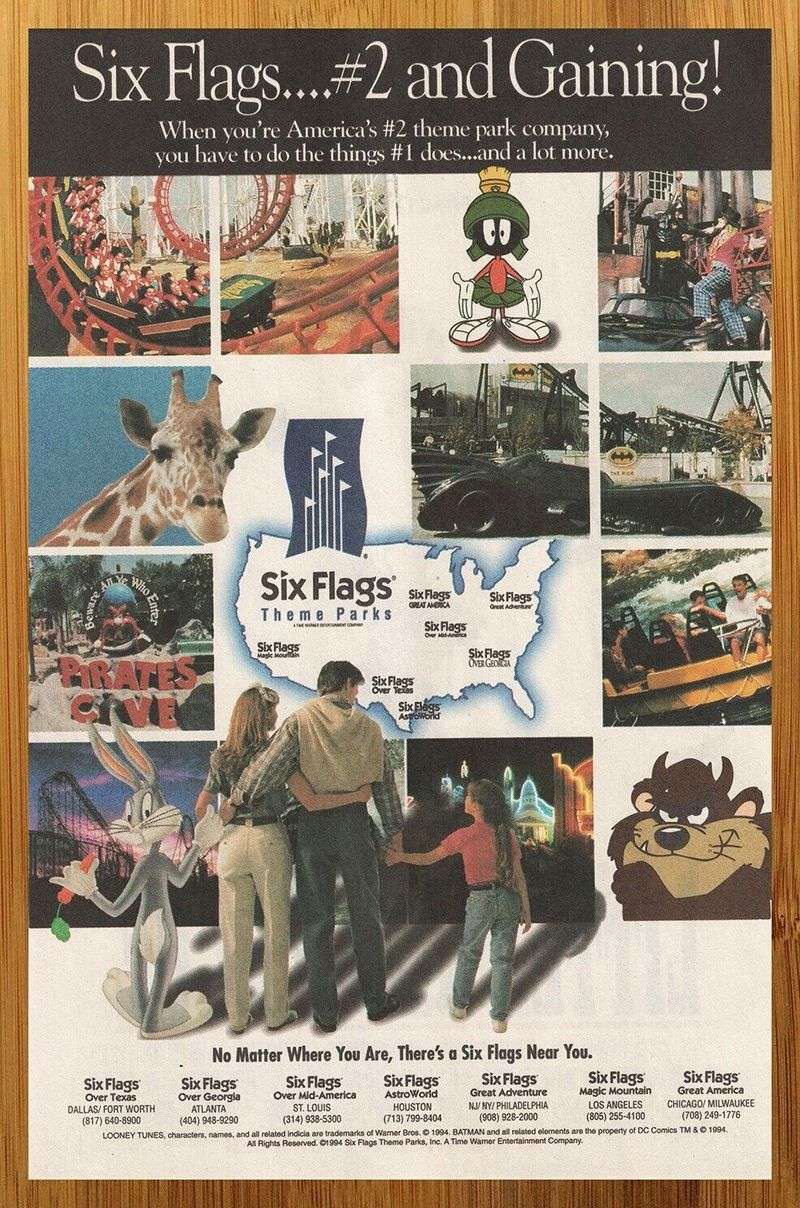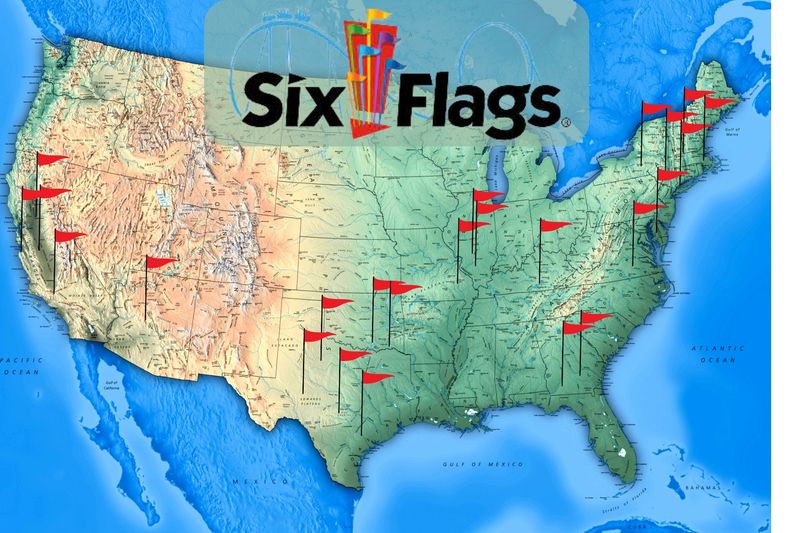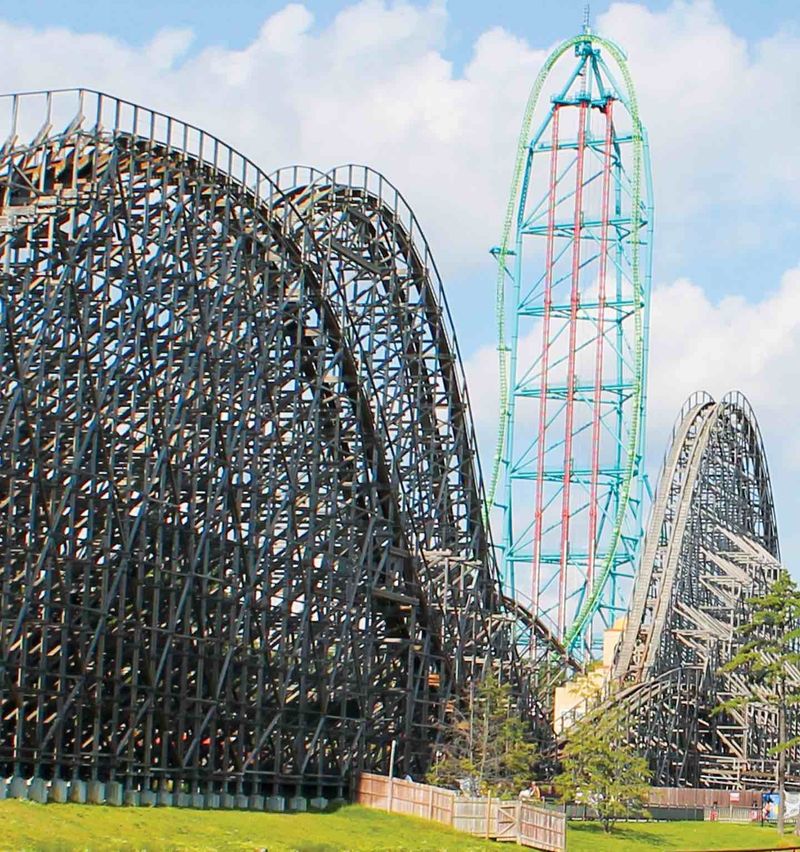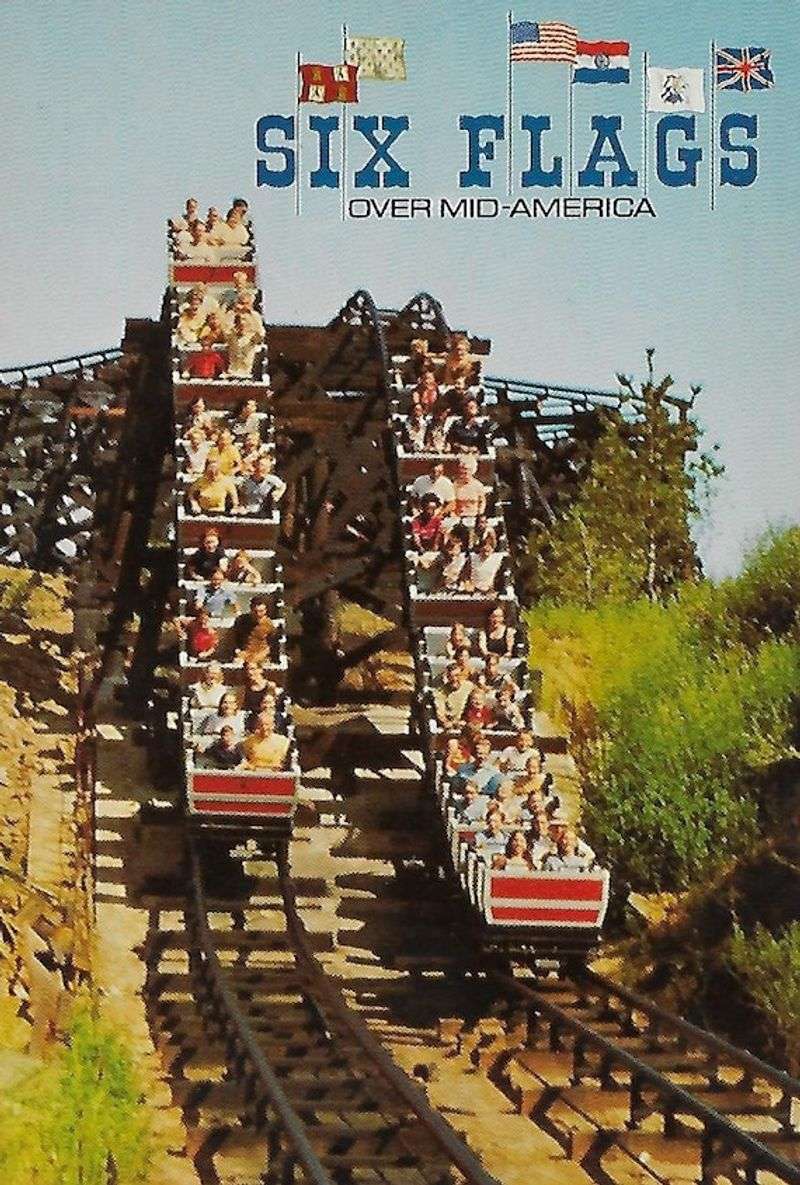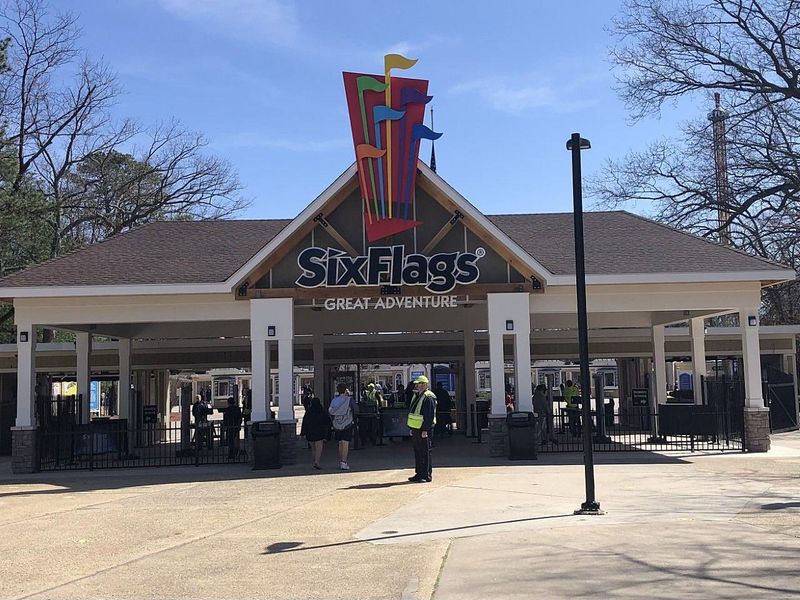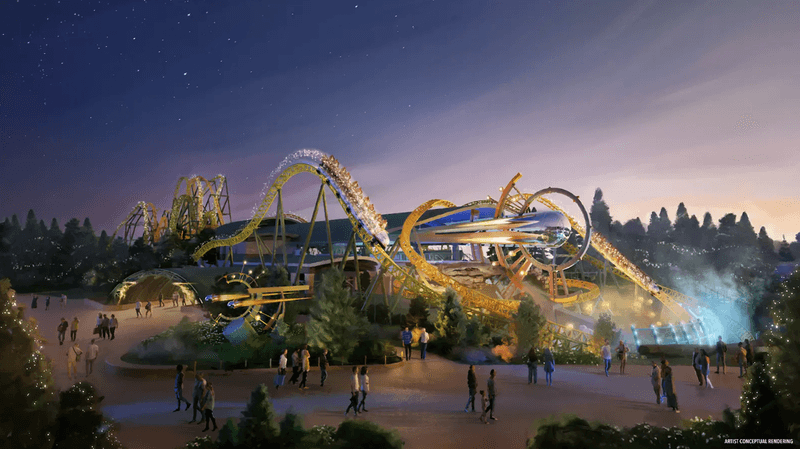Six Flags, a name synonymous with thrilling amusement park experiences, has a rich and varied history. From its inception in Texas to becoming a global franchise, there are many hidden aspects of its past that are not widely known. As one beloved park in Maryland faces closure, it’s time to reflect on the fascinating legacy of Six Flags.
1. Six Flags Started with a Texas History Theme
The first Six Flags park opened in Arlington, Texas, in 1961. It was themed around the six national flags that had flown over Texas, providing a mini history lesson with every ride. The park featured sections dedicated to different eras, from Spain to the Confederacy. Its unique theme was a major draw, allowing visitors to experience history in a vibrant way. This historical theme set Six Flags apart from other amusement parks of the time, creating a niche that combined education with entertainment, something rarely seen in amusement parks of that era.
2. It Was the First Park to Offer a Pay-One-Price Admission
Before Six Flags, most amusement parks charged per ride, making visits potentially costly. Six Flags revolutionized the industry by introducing a single admission price for unlimited access to all rides. This pricing model was innovative and attracted large crowds, allowing families to enjoy a full day of entertainment without worrying about extra costs. The simplicity and value of this approach made it a popular choice for families and set a new standard that many other parks would follow. It reshaped how people experienced amusement parks and contributed to Six Flags’ rapid growth.
3. Six Flags Once Owned Movie Studios
In the 1990s, Six Flags was owned by Time Warner, bringing in branded attractions like Batman and Looney Tunes. This integration of popular media characters boosted its popularity, attracting fans eager to experience their favorite movie and cartoon themes. The collaboration resulted in themed rides and shows, offering a new level of entertainment that appealed to both children and adults. These branded attractions were not only a hit but also a clever marketing strategy, leveraging Time Warner’s assets to enhance the park experience and drawing more visitors eager for a taste of Hollywood.
4. There Were Over 20 Parks at Its Peak
At its height, Six Flags operated more than 20 amusement parks across the U.S., Mexico, and Canada. This expansion made it one of the largest theme park companies in the world. Each park had its own unique attractions, catering to different regional audiences and expanding the brand’s reach. The growth was unprecedented in the amusement industry, positioning Six Flags as a leader. This widespread presence ensured that the thrills of Six Flags were accessible to a large audience, solidifying its reputation as a top destination for amusement enthusiasts. Its vast network was a testament to its popularity.
5. The Company Has Filed for Bankruptcy
Despite its success, Six Flags faced financial turmoil, leading to a Chapter 11 bankruptcy filing in 2009. The company was burdened with heavy debt and declining attendance, necessitating a significant reorganization. This move allowed Six Flags to restructure its finances, shedding underperforming assets and reassessing its business strategy. It was a turning point for the company, highlighting the volatile nature of the amusement industry. The filing underscored the challenges even successful enterprises face, reminding stakeholders of the importance of sustainable growth and adaptability in a competitive market.
6. Maryland’s Park Was Originally a Different Brand
Six Flags America, located in Maryland, has a unique history, starting as a wildlife preserve in the 1970s. It later transformed into Wild World, then Adventure World, before being acquired by Six Flags in 1999. This evolution reflects the changing landscape of amusement parks, adapting to shifting consumer interests. The park’s metamorphosis from a preserve to a full-fledged amusement park showcases the dynamic nature of the industry and Six Flags’ ability to integrate diverse attractions under its brand. The park’s legacy is a testament to its adaptability and enduring appeal to visitors.
7. The Park Features One of the Oldest Wooden Coasters in the U.S.
The “Wild One” roller coaster, a highlight of the Maryland park, holds a special place in amusement history. Originally built in 1917 and later relocated to Maryland, it is considered a national treasure. Its classic wooden design offers a nostalgic thrill for coaster enthusiasts, combining heritage with excitement. This historic ride has been meticulously maintained, ensuring it continues to deliver exhilarating experiences. The Wild One’s enduring popularity is a tribute to traditional amusement design, capturing the essence of early 20th-century thrill rides and preserving it for future generations.
8. Six Flags Once Had a Branded Water Park Chain
Six Flags expanded its offerings by developing Hurricane Harbor, a branded water park chain. Often located adjacent to its main parks, these water attractions drove multi-day attendance, encouraging visitors to extend their stay. Hurricane Harbor’s attractions ranged from thrilling water slides to relaxing lazy rivers, catering to diverse preferences. This strategic move not only increased park footfall but also diversified the entertainment options under the Six Flags umbrella. The addition of water parks showcased Six Flags’ innovative approach to amusement, enhancing the overall experience with aquatic adventures that complemented its traditional rides.
9. They Introduced Record-Breaking Coasters
Six Flags has continually pushed the boundaries of thrill rides with record-breaking coasters. Kingda Ka, the world’s tallest coaster, and El Toro, one of the fastest wooden coasters, are prime examples. These attractions are designed to deliver unparalleled excitement, drawing thrill-seekers from around the globe. The engineering marvels behind these coasters reflect Six Flags’ commitment to innovation and adrenaline-pumping experiences. Each ride offers a unique challenge, from staggering heights to dizzying speeds, ensuring visitors leave with unforgettable memories. These coasters position Six Flags as a leader in amusement innovation.
10. The Company Has Changed Ownership Multiple Times
Throughout its history, Six Flags has experienced numerous ownership changes, each impacting its direction. From private equity firms to media giants and individual investors, each owner brought a different vision and strategy. These shifts often influenced park funding, development, and branding, reflecting the complex nature of the amusement industry. With each change, Six Flags adapted, navigating challenges and capitalizing on opportunities. The company’s resilience through these transitions highlights its enduring appeal and ability to remain a significant player in the theme park landscape, despite the uncertainties of changing hands.
11. Declining Attendance Is Closing the Maryland Park
Recent reports indicate that Six Flags America in Maryland is facing closure due to dwindling visitor numbers and high operating costs. This decision marks the end of an era for thrill-seekers in the region. The park’s decline reflects broader trends in the amusement industry, where traditional parks struggle to maintain relevance amidst evolving consumer preferences. The closure is a poignant reminder of the challenges faced by older parks, as they compete with immersive, IP-driven experiences offered by industry giants. It underscores the shifting dynamics and the need for continual innovation to captivate audiences.
12. The Closure Reflects a Bigger Shift in Theme Parks
The impending closure of Six Flags America reflects a significant shift in the theme park industry. Today, the focus is on immersive, IP-driven experiences like those offered by Disney and Universal. Older parks, with traditional rides, find it challenging to compete as visitors seek new, engaging narratives. This trend highlights the evolving expectations of park-goers, demanding more interactive and personalized experiences. The shift calls for a reevaluation of amusement park strategies, emphasizing innovation and adaptation to stay relevant. Six Flags’ struggle is emblematic of broader industry trends, as parks navigate these transformative changes.


